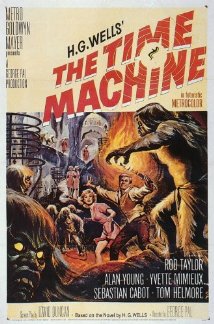In isolation, this film is an interesting and rather enjoyable tale. It is only when you appreciate the underlying theme in the original 1895 novel penned by H.G. Wells that you discovers how the story had been “laundered” to be “politically correct” for American public release. In a land where “socialism” has almost always been a dirty word and at a time when the McCarthy political witch hunts (that hit Hollywood rather badly) were still a fresh memory and when the “Cold War” was at its height, M.G.M. Studios was not going to take the risk of preaching a cautionary story about how the seeds sown by the capitalist system could exact a gruesome nemesis in a distant future. Instead, the studio took the story, stripped it of its ideology and presented it as the adventure of a gifted Victorian inventor.
Throughout his career, Herbert George Wells (1866-1946) placed his sympathies with the working class. In 1905, he joined the Fabian Society, a socialist think-tank whose ranks included George Bernard Shaw and that gave birth to the British Labour Party. It is not surprising that his ideology would embed itself in his writing — and this was certainly true of his first novel, The Time Machine. The book tells of an enterprising inventor who crafts a device that can carry a human passenger forward or backward through time. The hero travels 800,000 years into the future and finds a world in which humans had evolved into two species: an illiterate and child-like race called the Eloi, devoid of technology but similar in appearance to modern humans who inhabited the surface of the planet; and the more repugnant Morlocks, technologically sophisticated and living in perpetual darkness in underground caverns. The hero gradually learns that it is the Morlocks who supply the Eloi with food, clothing and other basic necessities of life, but they exact a terrible price. At periodic intervals, the Morlocks “harvest” the Eloi for food.
(By his own drive, Wells, who lived an impoverished childhood and became literate only in his teen years, entered university where he studied biology under Thomas H. Huxley, the illustrious and outspoken champion of Charles Darwin. He was aware of the debates among evolutionary biologists of his day over the discovery of Neanderthal remains, about how two “distinct” species of humans — Neanderthals and our Cro-Magnon ancestors — existed in a prehistoric Europe and whether it was a peaceful co-existence or whether the two species competed, perhaps violently, for control of resources. Wells merely extrapolated the concept of two competing human species to a distant future.)
The hero in the novel also discovers how this world came into being. At some less remote future time, the industrialists collectively chose to establish their factories and means of production underground, leaving the surface of the earth green. Eventually, the politically powerful classes decided to banish all workers underground as well, leaving the world of sunshine and blue skies as a playground for the wealthy and the privileged — a paradise that would eventually turn sour when the passage of time would adjust the genetic makeup of the two classes in their different environments and when a successful “slave revolt” would place the descendants of the workers in control.
Clearly, such a political fable could not be put on screen in the United States in 1960. If a cinematic version of the story was going to be made, another explanation had to be conjured up to account for the evolution of the two human species — and it was found in the Cold War itself, a war that turns “hot” and forces huge populations underground for survival. Toady, however, almost forty years after the movie was released and more than a hundred hears since the novel first broke onto the world, that M.G.M. explanation seems horribly dated and it is the original Wells plot that holds up much better in today’s international, political and industrial climate.

